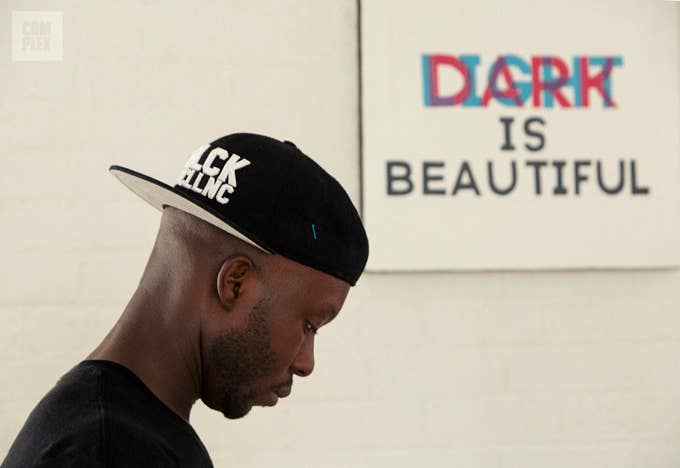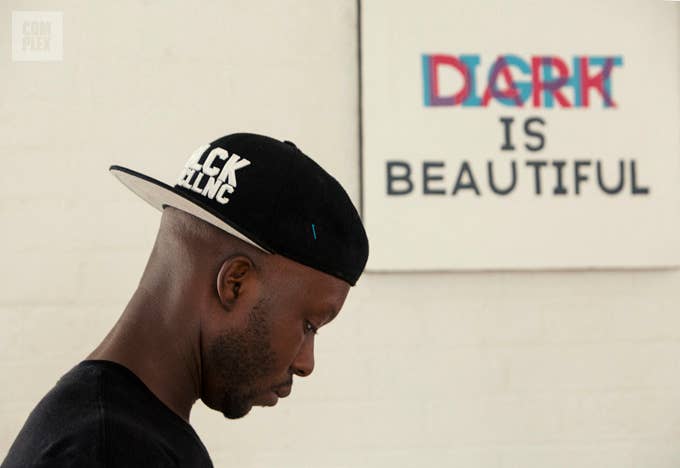
Multimedia artist Andre Woolery has been challenging perceptions surrounding black identity for his entire career. Complex recently sat down with the artist in Tribeca to talk about his work, the fluid nature of black identity, and his creative inspiration. This interview was performed in partnership with Peet’s Coffee who are celebrating the passion that drives people like Andre in the pursuit of their craft.

"I was born in Morristown, NJ. First generation Jamaican. I was the first person in my family born here. [Morristown’s] a pretty diverse place, but then you go to Jamaica and it is a majority black country. You get to have a different understanding of being black with that contrast. [In the States] from a media standpoint, you don't see yourself. You only see yourself in certain areas. You go to Jamaica and the TV is filled with people that look like you. You have a different perspective and you feel a little bit like you belong in this world and you're a part of this world in a certain way.
My dad’s a welder. Growing up, we had a million things made of metal at our house. Anything we wanted that he couldn't buy, he would make out of metal. [There was] this culture that I was raised up in where no matter what you want to do, there's a creative way to figure it out: creativity became the tool."

"When I was younger, I used to draw comic book characters. My mom got me a Bob Ross painting set because I was like, 'Yeah, I can do whatever he's doing. That's easy.' I did it. Then a friend came over, loved it. [Their] mom came over, loved it and I sold it to her. I was on the soccer team at the time and I was hustling Bob Ross paintings to all the soccer moms. That was my way to make money in high school. Saved up for a bike."


"Then you start getting older and older, and as you get older it starts to change. I ended up focusing on things that were technical. I got a Computer Science degree. When I came out of school I got a job and then started working in advertising. It was all technical. It was all digital-based and I just wasn't doing anything art related.
My wife saw all these sketches I used to do when I was younger and was like, 'What the hell is going on? You don't do any of this now.' One Christmas, she bought me a whole bunch of oil paints, an easel, brushes and was like, 'You need to get back into art.'
Where I'm at now, is really interesting because I was doing digital things for a while. Reintroduced myself to art. At that moment, I started to push away the digital side of myself. I was trying my best to focus on art and keep the digital thing to the side. I was working in the daytime doing this, then doing art at night. Then slowly I shifted to try to do art full time. I got to that point, and I was working and creating. Then I started to reevaluate what I was doing. I recognized the thing that I was missing was, I wasn't bringing the sides of myself together."


"WHATEVER BLACKNESS AND BLACK IDENTITY MEANS NOW, IS NOT WHAT IT MEANS TOMORROW. IT'S REALLY SOMETHING FLUID THAT EVERY PERSON AND EVERY GENERATION INFLUENCES."

"I've always wanted to find a way to make a flat image animate. [Yet] the framework that I was presented with was, I can do two things: I can show one light on one side and show another light on one side and they can change.
Whenever anyone has a discussion around any topic, you exist on one side somehow. You have a perspective, you have an opinion and you're on one side. Then there's obviously an opposite side.
I recognize this allows me to bring people back and forth on both sides. Create an exercise where your mind stops thinking about the side you're on and just vacillates between the two sides and then two perspectives of two opinions to really think about where each person stands, where a certain topic exists. Then from there I think you'll get a better perspective on things."

"As I explore blackness and black identity, there's a perspective on this side of the spectrum, there's a perspective on that side of the spectrum. How do you just jump between sides? That's where this lighting thing came about. Controversial things that are controversial within the black community, such as the N-word, those things around skin tone, those things around hair perception, beauty perception. I just recognized there's a rich territory to explore those things.
I recognized that black identity and blackness and black culture is not a stagnant thing. It's a fluid thing. It moves just like the lighting. It goes back and forth, it changes, the conversation evolves. Whatever blackness and black identity means now, is not what it means tomorrow, it's not what it means the next day. At the end of the day, it's really something fluid that every person, every generation influences—it's constantly evolving."
"I'm inspired by artists and different things constantly. In the beginning, it was someone like a Kehinde Wiley. I look into a gallery, and there was this massive painting. It was a black guy. I was like, 'Holy shit! I've never seen someone that looked like me on that grand scale, in that beautiful gesture.' I was immediately blown away. The simplicity of looking into somewhere. Not even understanding what was going on with the work. Not even going any deeper to be like, 'Okay, what does this mean. Who is this? Who's creating this?' It was just literally, I was stuck in my tracks on the sidewalk and I was like, 'Whoa, what is that?' Then it opened my mind at that point to realize that art is a powerful tool.
I actually don't look towards art that often for inspiration because I feel like disparate things coming together is where you take leaps and bounds. [When I did] this lighting thing, I was reading physics stuff. It had nothing to do with art. It was just the notion of what's happening with color, what do I need to understand about color and light and all of that kind of stuff."
"I think when you make art, it's about patience and I think when you view art you have to be patient to view it and start to evaluate it in terms of what it's made of, who made it, what are their intentions, what it means to you, all those different things. We're in a world where you just give something a short amount of attention and you move on. There's many ways to view it, but at the end of the day, if you give it your undivided attention, it'll give you something back."

Inspired by Woolery’s story? Share your passion on peets.com/passion for a chance to win a year of free Peet’s Coffee and be inspired by the stories of others pursuing their craft.

